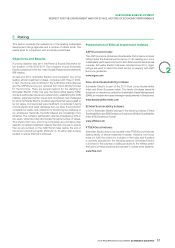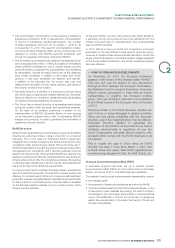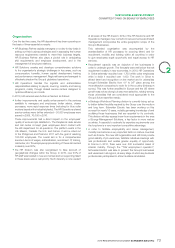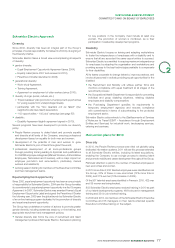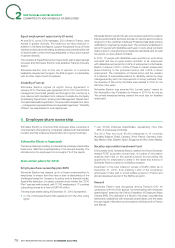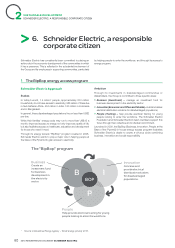APC 2010 Annual Report Download - page 73
Download and view the complete annual report
Please find page 73 of the 2010 APC annual report below. You can navigate through the pages in the report by either clicking on the pages listed below, or by using the keyword search tool below to find specific information within the annual report.
SUSTAINABLE DEVELOPMENT
SCHNEIDER ELECTRIC’S COMMITMENT TOENVIRONMENTAL PERFORMANCE
Management of waste, emissions and industrial
pollution
Waste
Because waste is a major source of pollution but also a potential
source of raw materials, waste management is a priority in
environmental protection.
Most of the Group’s waste is solid waste. Continuous improvement
plans have been deployed to manage this waste. This approach
fi ts in fully with the ISO14001 approach that all Schneider Electric
production and logistics sites worldwide are required to follow.
Because classifi cation systems vary widely from country to country,
the Group does not consolidate global data by category (hazardous
and non-hazardous). Data is processed to ensure local traceability.
In France, for example, hazardous industrial waste accounts for
around 14% of total waste. All waste is channeled to the appropriate
treatment facility.
Schneider Electric notes the quantities of waste produced and
recycled on a six monthly basis and monitors this production per
capita, on a like-for-like basis in order to evaluate its performance
from one year to the next.
The overall eco-production approach helped reduce our production
of waste by 4.8% per capita in 2010 compared with 2009 on a
comparable basis and to increase the proportion of waste recycled
from 80% in 2009 to 84% in 2010 on a comparable basis. The
Group has not deployed any specifi c Group action plan in this area
in 2010.
Conditions of use and soil contamination
Virtually all Schneider Electric sites are located in urban or industrial
areas and do not affect any notable biotopes. None of the Group’s
businesses involve extraction or land farming.
No substances are purposely released into the soil in the course
of site operation. Workshop fl ooring is specially treated to prevent
any leakage. Hazardous substances are systematically stored
and handled in areas equipped with retention tanks. Retention
systems are designed to compensate in the event of malfunctions
or emergencies, such as fi res.
In 2010 Schneider Electric conducted its annual review of pollution
risks at all manufacturing sites as part of ISO14001 tracking. No
major incident was reported in 2010.
Discharge into the water and air
Because Schneider Electric is mainly an assembler, its discharge into
the air and water is very limited. Mechanical component production
workshops are carefully monitored, in keeping with their ISO14001
certifi cation. Their releases are tracked locally as required by current
legislation. No major spills or discharges were reported in 2010.
Noise and odors
All Schneider Electric sites comply with noise and odor limits.
Environmental risk management and prevention
The ISO 14001 environmental management system covers
management of environmental risks. No Schneider Electric sites are
Seveso classifi ed. Aside from the voluntary prevention measures
discussed above for sites with a soil contamination history, no
amounts have been paid out in connection with a legal ruling.
All of the Group’s industrial sites, which are ISO14001 certifi ed, have
procedures in place to prevent emergencies and respond effectively
if necessary. Preventive and corrective action plans are based on an
analysis of non-standard situations and their potential impact. This
analysis draws in part on hazard reviews for classifi ed installations.
In France, for example, certain sites that handle large amounts of
chemical compounds, such as Le Vaudreuil, MGA and 38TEC,
are equipped with balloon-type containment systems to avoid any
pollution through the water network. Others, located next to a river,
have fl oating beams.
Drills are held regularly throughout the year to ensure that supporting
procedures are ready and effective.
A national organisation has been set up to track sensitive sites.
Their managers systematically receive training in environmental
crisis management. Directives, procedures and national guidelines
concerning environmental crisis management, historical and
current operations management, pollution risk prevention and other
topics are available on the intranet. Internal audits verify that these
procedures are applied correctly.
2010 REGISTRATION DOCUMENT SCHNEIDER ELECTRIC 71
2


